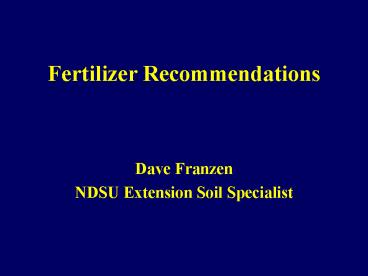Fertilizer Recommendations - PowerPoint PPT Presentation
1 / 27
Title:
Fertilizer Recommendations
Description:
Fertilizer Recommendations. Dave Franzen. NDSU Extension Soil ... agri-climatology zones within ND, they. each had different response curves. This is Langdons ... – PowerPoint PPT presentation
Number of Views:204
Avg rating:3.0/5.0
Title: Fertilizer Recommendations
1
Fertilizer Recommendations
- Dave Franzen
- NDSU Extension Soil Specialist
2
Fertilizer recommendations through NDSU are
available for ALL MAJOR CROPS and several minor
crops.
3
Recommendations that are recent and that I am
very confident about Canola, Flax, Barley,
Sugarbeet, Dry beans
4
Recommendations that are out-of-date and I am
not confident in them as currently
written Wheat, corn, sunflower, most others
5
Several at NDSU have been working to update
wheat N recommendations for five years. I
gathered all of our modern N calibration data
(since 1970) along with recent and ongoing
research. Here is what we have learned to date-
6
(No Transcript)
7
(No Transcript)
8
The optimum economic N rate for 8 wheat is about
175 lb/a less credits. For 7 wheat, it is only
about 150 lb N/a. 6 wheat, even lower.
9
When we partitioned out different
agri-climatology zones within ND, they each had
different response curves. This is Langdons-
10
From Jamestown east, excluding the Langdon area,
the responses are quite different. At 7 wheat
and above at 80 cent N, the rate is up to the
grower and their banker. At 6 wheat- THERE IS
NO ECONOMIC RESPONSE TO N!
11
The area from Jamestown west, including
west-river, is more responsive to N than in the
east. Economic return is up to the grower and
the banker with risk considered.
12
There is ample evidence that within a region an
organic matter adjustment to make between fields
or within fields may be justified. We are
planning a series of experiments state-wide in
2009 that will address that question. After
those experiments are completed, the new
recommendations will be formulated.
13
Our current corn recommendation is- NR Yld Pot
X 1.2 less credits Most other states have
rejected these recommendations. Most have gone
to a flat rate of some formula that has included
organic matter.
14
Minnesota recommendations suggest an N rate of
about 150 lb N/a for corn after corn (or a
non-legume) and about 110-120 lb N/a following
soybean. We should probably pay more attention
to numbers around these than our current
recommendation.
15
In the east, a good N rate to use in highly
productive soils would be around 150 lb N/a less
credits. In the west, no less than 100 lb N less
credits should be used. Under irrigation, total
N may be more because of increased production,
lower organic matter in our sandy irrigated
soils and leaching potential. Increased rates
should be guided by tissue sampling.
16
For sunflower- I would be reluctant to recommend
more than 100 lb N less credits because of the
sunflower rooting depth. Under many fields,
under the 3 foot depth lies higher residual N
than anticipated. Sunflower can pick this up when
other crops cannot.
17
Other nutrients- P- Our P recommendations were
developed when P costs were about 15 cents/
lb. Now they are more than 1. Economics have
changed. Our tables dont work anymore for any
crop.
18
(No Transcript)
19
Banding P increases its efficiency. For any
crop, if P is banded when soil test P is medium
or higher, rates can be cut by 1/3. If P is low
or lower, rates can be cut by ½. P farther from
the seed than about 2 ½ inches is NOT a starter
application. Crops that need a starter will need
something near the seed.
20
Crops that do best with a starter- Corn (were
north of Dekalb) Wheat Barley (really
important!!!) Canola (really important!!!) Potato
Sugarbeet (unless you have to burn)
21
Crops that dont respond to starter Soybean Peas
Most legumes Sunflower
22
Crops that dont respond to P at all- Flax
23
Potassium- Our sandy soils in the east will
probably still need K. Reduce table values by
1/3 if banding. Dont try to build K in a sand-
it wont work. If you are using 0-0-60 for small
grains, it will cost about 7.50 to achieve an
average 2 bu/a gain. Do the math.
24
Sulfur- Consider S based on recent weather and
the soil. Low rainfall- low potential of
response Sands- high potential of response High
rainfall and sandy soil- USE S! (Soluble sulfur,
not elemental in any form)
25
Zinc- Corn, potato, dry beans (not soybeans)
and flax. Soil applied better than
foliar. Soil test is very good predictor- Need 1
ppm on a soil test. Zone sampling is good 0-6
inch depth only.
26
Other micronutrients??? Copper sometimes, but
not while the cost is so high that people might
steal your air conditioning unit. Iron-
FE-EDDHA- available as Soy-Green the best hope
right now. Relatively inexpensive and works
surprisingly consistently on not-too-salty soils.
27
Questions????































